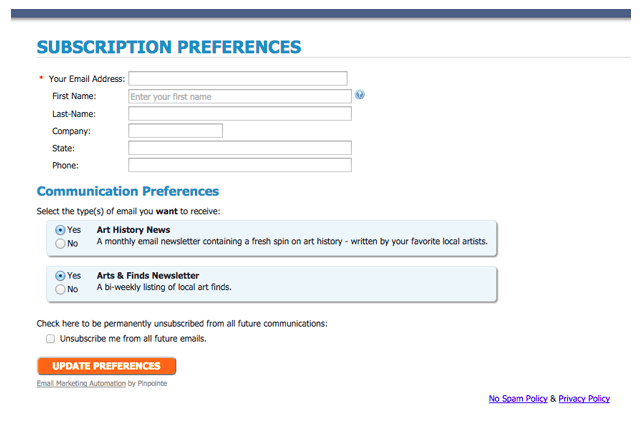Trees are budding, birds are chirping and there’s a fresh scent in the air. Spring is here.
There’s something about this season that makes people want a fresh start, which is probably why 72 percent of Americans use this time for spring cleaning. While many clear closets, shine floors and remove year-old cobwebs, there’s an area you’re likely overlooking: your email list.
How much cleaning or maintenance have you done to your email list this year? Not a lot, right? Not to worry. Now is the time to dust off your email list, scrub away old contacts and make your list as tidy as the playroom that you spent days organizing.
Here are seven tips to spring clean your email list:
1. Organize your lists
How organized is your email list? Are you segmenting it? Segmenting your email list is like organizing a closet full of clothes into separate totes. You can organize clothes by size, season or color. It’s the same with your email list. You can break it up into groups based on categories like age, gender, buying habits or the kind of email they’ve signed up for.
Segmenting your list has big benefits. Thirty-nine percent of email marketers that practice list segmentation see better open rates; 28% see lower opt-out and unsubscribe rates; and 24% see better email deliverability, increased sales leads and greater revenue.
Not sure which categories to segment your list into? Here’s a list. You can segment your list by:
- Location
- Age
- Sex
- Job title
- Industry
- Buying habits
- Point in sales cycle
- Kind of emails, like newsletter only or events only
Pinpointe users can create organized lists, and even generate a hierarchy for easy reference.
2. Check for duplicates and domain misspellings
When you’re dealing with a lot of names and email addresses, it can be cumbersome to manage. You can upload a large list of contacts, but what if there are duplicates on the list?
Another common mistake is misspelled domain names. If you enter contacts manually, you may have misspelled it or the contact could have inadvertently mixed up the letters.
Both mistakes are costly. You’ll want to scan your list for both errors.
Fortunately, many email service providers, like Pinpointe, provide this service for you. Duplicate names are automatically detected and removed, and misspellings in domain names are corrected to ensure your list is as accurate as possible.
3. Remove inactive customers
It’s hard to get rid of things when you’re spring cleaning, but when it comes to your email list, if you hang on to inactive customers too long it can hurt you.
If you let inactive customers linger on your list, it can distort your statistics. It’s better to remove inactive customers and spend your time focused on active ones.
When should you remove customers? It’s a tough question, and it really depends on your buying cycle. If customers buy from you once a week, that’s a drastically different sales cycle than customers buying twice a year.
You have to set a timeframe that’s right for your business. Having said that, there is a rule of thumb that most businesses follow when it comes to removing contacts. If a contact has gone a year without opening an email, or engaging with your business, it’s time to remove him or her from the list.

If you chose, you can send a final email that asks the subscriber if he or she is still interested in receiving your messages. If it goes unopened, you’ve certainly got your answer.
To prevent contacts from falling into the “inactive abyss,” try to re-engage them sooner. When a customer goes a few months without opening an email, put them into a specific “at risk” email segment.
Create a campaign specifically for this group with the intent to bring them back. For example, send an email that says, “We Miss You” with some kind of discount or incentive to buy.
This effort should keep a portion of your “at risk” contacts from sliding into the inactive category and being wiped from your list altogether.
4. Manage bounced emails
To spruce up your list, you’ll need to manage bounced emails. There are two types: hard and soft bounces.
A hard bounce is an email that can’t be delivered for permanent reasons like an invalid email address. If your email comes back as a hard bounce, remove that contact from your list immediately. It’s never going to turn into a prospective customer, and keeping it around could get you blacklisted from your internet service provider.
A soft bounce is a “temporarily undeliverable email.” The email address exists, but there’s a reason the email couldn’t be delivered like the server is down or the subscriber’s inbox is full. If an email soft bounces five times, you should consider that contact a loss and remove it from your list.
Fortunately, email service providers like Pinpointe automatically process bounced emails. If an email hard bounces, it’s removed from your list. If an email soft bounces five times, it’s treated as a hard bounce and automatically erased from your list.
5. Remove unsubscribers quickly
Every email must allow subscribers to opt-out of your email list. It’s actually a law. The CAN-SPAM Act requires each email message to have a clear way for subscribers to end communication with you.
If a subscriber decides to go, make sure you remove him or her from your list quickly. If you leave the subscriber on your list, you could be reported for SPAM, which hurts your email reputation. After opt-out, 95 percent of companies remove contacts within 10 days.
It’s another feature that Pinpointe helps its users with. Subscribers that want off your mailing list are automatically removed.
6. Set up an email preference center
Removing contacts that no longer want to hear from you is a necessity, but you can slow the leaky faucet of contacts that drip away by creating an email preference center.
Your unsubscribe link can lead subscribers to a preference center where they can limit the amount of emails they receive rather than leave altogether. Pinpointe allows users to create an email preference center. Here’s an example:
By giving subscribers the option to reduce email frequency, you can hang on to a significant number of contacts. Fifty-three percent of subscribers say the number one reason they unsubscribe is because they receive too many emails; so offering this alternative is a healthy way to maintain your email list. Think of it as preventative maintenance to limit your spring cleaning efforts next year.
7. Set up a double-opt in process
Spring cleaning isn’t just about dealing with the mess at hand; it’s also about creating a plan to eliminate messy problems in the future.
One proactive way to keep your list squeaky clean is to create a double-opt in process. When a prospective customer signs up for your list, he or she receives an email with a confirmation link that must be clicked before being added to your email list.
Pinpointe customers can optionally set up a double opt-in feature and use ready-made forms to make the process simple.
How does this help your cleaning efforts? The double-opt in process assures you that every contact that signs up, not only wants to be on your list, but also provided a valid email address.
Like creating an email preference center, this step can reduce your cleaning time next year by creating a list of real contacts that are genuinely interested in your business or product.
Wrap up
 It’s a good idea to take a scrub brush to your email list once a year. It can be a little consuming, but hopefully your email service provider has some cleaning tools that you can use to make the process easier.
It’s a good idea to take a scrub brush to your email list once a year. It can be a little consuming, but hopefully your email service provider has some cleaning tools that you can use to make the process easier.
By following the tips above, you’ll ensure that your email list is full of shiny, happy contacts.
Just as you have a sense of accomplishment after purging junk from your home, you’ll have a similar feeling after spring cleaning your email list.







